Use of the Ball-Cratering Method to Assess the Wear Resistance of a Welded Joint of XAR400 Steel
Abstract
1. Introduction
2. Materials and Methods
2.1. Welding Process
2.2. Structural Characterization
2.3. Tribological Tests
- Zone 1—base material not affected by the heat (BM)
- Zone 2—partially heat-affected zone (PHAZ II)
- Zone 3—partially heat-affected zone (PHAZ I)
- Zone 4—heat-affected zone (HAZ)
- Zone 5—root weld zone (WZ I)
- Zone 6—stitch weld zone (WZ II)
2.4. Testing Methodology
- friction assembly load: 0.4 N;
- counter-sample rotational speed: 150 rpm;
- sliding distance 179.5 m;
- test duration: 15 min.
3. Results and Discussion
3.1. Roughness Tests Results
3.2. Hardness Tests Results
3.3. Joint Microstructure
3.4. Crystalline Structure Analysis
3.5. Wear Test Results
4. Conclusions
- Obtained results demonstrate that the size of crystallites along [110] and [200] directions increase within recast layer (welded joint), HAZ and PHAZ zones. On the other hand, size dispersion σ is found to be smaller along [200] than [100] axis.
- Abrasive wear rates in different parts of the welded joint, determined using the ball-cratering method, indicate that the material in the HAZ has the lowest resistance to abrasive wear. The value of wear rate in this area is 2.5 times higher than that in the unwelded material. The obtained results of the wear index indicate a decrease in the resistance of the welded joint material as it approaches the joint axis.
- The ball-cratering method can be successfully used to evaluate the tribological properties of welded joints in their cross section. Due to small wear trace, it is possible to determine cross-sectional maps of the abrasion resistance of areas of various structural characteristics. Further investigations might be extended into using this method for mapping of the wear rate of the weld joints of other geometries.
Author Contributions
Funding
Institutional Review Board Statement
Informed Consent Statement
Data Availability Statement
Conflicts of Interest
References
- Konat, Ł.; Jasiński, R.; Białobrzeska, B.; Szczepański, Ł. Analysis of the static and dynamic properties of wear-resistant Hardox 600 steel in the context of its application in working elements. Mater. Sci. 2021, 39, 86–102. [Google Scholar] [CrossRef]
- Białobrzeska, B.; Jasiński, R.; Konat, Ł.; Szczepański, Ł. Analysis of the Properties of Hardox Extreme Steel and Possibilities of Its Applications in Machinery. Metals 2021, 11, 162. [Google Scholar] [CrossRef]
- Konat, Ł.; Pękalski, G. Overview of Materials Testing of Brown-Coal Mining Machines (Years 1985–2017). In Mining Machines and Earth-Moving Equipment: Problems of Design, Research and Maintenance; Springer International Publishing: Cham, Switzerland, 2020; pp. 21–58. [Google Scholar] [CrossRef]
- Adamiak, M.; Górka, J.; Kik, T. Comparison of abrasion resistance of selected constructional materials. J. Achiev. Mater. Manuf. Eng. 2009, 37, 375–380. [Google Scholar]
- Bhakat, A.K.; Mishra, A.K.; Mishra, N.S. Characterization of wear and metallurgical properties for development of agricultural grade steel suitable in specific soil conditions. Wear 2007, 263, 228–233. [Google Scholar] [CrossRef]
- Białobrzeska, B. The influence of boron on the resistance to abrasion of quenched low-alloy steels. Wear 2022, 500–501, 204345. [Google Scholar] [CrossRef]
- Liu, Y.; Liskiewicz, T.W.; Beake, B.D. Dynamic changes of mechanical properties induced by friction in the Archard wear model. Wear 2019, 428–429, 366–375. [Google Scholar] [CrossRef]
- Archard, J.F.; Hirst, W. The wear of metals under unlubricated conditions. Proc. R Soc. Lond Ser. A Math Phys. Sci. 1997, 236, 397–410. [Google Scholar]
- Hsu, S.M.; Shen, M.C.; Ruff, A.W. Wear prediction for metals. Tribol. Int. 1997, 30, 377–383. [Google Scholar] [CrossRef]
- Huq, M.Z.; Celis, J.P. Expressing wear rate in sliding contacts based on dissipated energy. Wear 2002, 252, 375–383. [Google Scholar] [CrossRef]
- Bramowicz, M.; Kulesza, S.; Lewalski, P.; Szatkowski, J. Structural Studies of Welds in Wear-Resistant Steels. Acta Phys. Pol. A 2016, 130, 963–965. [Google Scholar] [CrossRef]
- Gáspár, M. Effect of Welding Heat Input on Simulated HAZ Areas in S960QL High Strength Steel. Metals 2019, 9, 1226. [Google Scholar] [CrossRef]
- Lu, Y.; Peer, A.; Abke, T.; Kimchi, M.; Zhang, W. Subcritical heat affected zone softening in hot-stamped boron steel during resistance spot welding. Mater. Des. 2018, 155, 170–184. [Google Scholar] [CrossRef]
- Saxena, A.; Kumaraswamy, A.; Madhu, V.; Madhusudhan Reddy, G. Study of Tribological Characteristics of Multi-pass SMAW Armox 500T Steel Joints. J. Mater. Eng. Perform. 2018, 27, 4300–4307. [Google Scholar] [CrossRef]
- Montero, J.; García, A.; Varela, A.; Zaragoza, S.; Artiaga, R.; Mier, J.L. A study on wear of welded joins for pipelines. Weld. Int. 2010, 24, 120–124. [Google Scholar] [CrossRef]
- Hou, W.; Ding, Y.; Huang, G.; Huda, N.; Shah LH, A.; Piao, Z.; Gerlich, A. The role of pin eccentricity in friction stir welding of Al-Mg-Si alloy sheets: Microstructural evolution and mechanical properties. Int. J. Adv. Manuf. Technol. 2022, 121, 7661–7675. [Google Scholar] [CrossRef]
- Paula, T.C.; Mazzaferro, C.C.P.; Giarollo, D.F.; Hidalgo, G.E.N.; Basso, B. Effect of autogenous GTAW on the reciprocating sliding wear behavior of a carbon, martensitic steel. Acta Scientarium. Technol. 2021, 43, e50488. [Google Scholar] [CrossRef]
- Roshanghias, A.; Barzegari, M.; Kokabi, A.H.; Mirazizi, M. The effects of functionally graded material structure on wear resistance and toughness of repaired weldments. Mater. Des. 2011, 32, 892–899. [Google Scholar] [CrossRef]
- Konat, Ł.; Białobrzeska, B.; Białek, P. Effect of Welding Process on Microstructural and Mechanical Characteristics of Hardox 600 Steel. Metals 2017, 7, 349. [Google Scholar] [CrossRef]
- Nikolaevich, M.; Brykov, I.; Petryshynets Džupon, M.; Kalinin, Y.A.; Efremenko, V.G.; Makarenko, N.A.; Pimenov, D.Y.; Kovác, F. Microstructure and Properties of Heat Affected Zone in High-Carbon Steel after Welding with Fast Cooling in Water. Materials 2020, 13, 5059. [Google Scholar] [CrossRef]
- Górka, J. The assessment of the quality of welded joints made of abrasion-resistant plates using the nanocrystalline filler metal. J. Min. Metall. Sect. B Metall. 2020, 56, 209–220. [Google Scholar] [CrossRef]
- Konat, Ł.; Białobrzeska, B. Effect of Welding Technique and Thermal Heatment Parameters on Abrasive Wear of Steel S355. Tribologia 2022, 3, 25–38. [Google Scholar] [CrossRef]
- Montero, J.; Filgueira, A.; García-Diez, A.; Mier, J.L.; Camba, C. The Wear Responses of the Welded Joints of ASTM A335 Gr. P11 Steels Affected by Accelerated Flow Corrosion. Materials 2019, 12, 3630. [Google Scholar] [CrossRef]
- Stachowiak, G.B.; Stachowiak, G.W.; Celliers, O. Ball-Cratering Abrasion Tests of High-Cr White Cast Irons. Tribol. Int. 2005, 38, 1076–1087. [Google Scholar] [CrossRef]
- Mathew, M.T.; Stack, M.M.; Matijevic, B.; Rocha, L.A.; Ariza, E. Micro-Abrasion Resistance of Thermochemically Treated Steels in Aqueous Solutions: Mechanisms, Maps, Materials Selection. Tribol. Int. 2008, 41, 141–149. [Google Scholar] [CrossRef]
- Marques, F.; da Silva, W.M.; Pardal, J.M.; Tavares, S.S.M.; Scandian, C. Influence of Heat Treatments on the Micro-Abrasion Wear Resistance of a Superduplex Stainless Steel. Wear 2011, 271, 1288–1294. [Google Scholar] [CrossRef]
- Vale Antunes, P.; Ramalho, A. Study of Abrasive Resistance of Composites for Dental Restoration by Ball-Cratering. Wear 2003, 255, 990–998. [Google Scholar] [CrossRef]
- Sharifi, S.; Stack, M.M.; Stephen, L.; Li, W.-L.; Wang, M-C. Micro-Abrasion of Y-TZP in Tea. Wear 2013, 297, 713–721. [Google Scholar] [CrossRef]
- Sampaio, M.; Buciumeanu, M.; Henriques, B.; Silva, F.S.; Souza, J.C.M.; Gomes, J.R. Comparison Between PEEK and Ti6Al4V Concerning Micro-Scale Abrasion Wear on Dental Applications. J. Mech. Behav. Biomed. Mater. 2016, 60, 212–219. [Google Scholar] [CrossRef]
- Farfán-Cabrera, L.I.; Gallardo-Hernández, E.A.; Sedano de la Rosa, C.; Vite-Torres, M. Micro-Scale Abrasive Wear of Some Sealing Elastomers. Wear 2017, 376–377, 1347–1355. [Google Scholar] [CrossRef]
- Ligier, K.; Olejniczak, K.; Napiórkowski, J. Wear of polyethylene and polyurethane elastomers used for components working in natural abrasive environments. Polym. Test. 2021, 100, 107247. [Google Scholar] [CrossRef]
- Batista, J.; Joseph, M.; Godoy, C.; Matthews, A. Micro-Abrasion Wear Testing of PVD TiN Coatings on Untreated and Plasma Nitrided AISI, H13 Steel. Wear 2002, 249, 971–979. [Google Scholar] [CrossRef]
- Silva, F.; Martinho, R.; Baptista, A. Characterization of Laboratory and Industrial CrN/CrCN/Diamond-Like Carbon Coatings. Thin Solid Film. 2014, 550, 278–284. [Google Scholar] [CrossRef]
- Osuch-Słomka, E.; Michalczewski, R.; Szczerek, M. Ocena odporności na zużywanie powłok PVD/CVD metodą ball-cratering. Tribologia 2007, 213–214, 47–58. [Google Scholar]
- Napiórkowski, J.; Ligier, K.; Lemecha, M.; Fabisiak, D. Evaluation of tribological properties of powder paint coatings using the ball-cratering method. Q. Tribol. 2019, 288, 57–63. [Google Scholar] [CrossRef]
- Gee, M.G.; Wicks, M.J. Ball Crater Testing for the Measurement of the Unlubricated Sliding Wear of Wear-Resistant Coatings. Surf. Coat. Technol. 2000, 133–134, 376–382. [Google Scholar] [CrossRef]
- Cozza, R.C. Influence of the Normal Force, Abrasive Slurry Concentration and Abrasive Wear Modes on the Coefficient of Friction in Ball-Cratering Wear Tests. Tribol. Int. 2014, 70, 52–62. [Google Scholar] [CrossRef]
- Peng YNi, X.; Zhu, Z.; Yu, Z.; Yin, Z.; Li, T.; Liu, S.; Zhao, L.; Xu, J. Friction and Wear of Liner and Grinding Ball in Iron Ore Ball Mill. Tribol. Int. 2017, 115, 506–517. [Google Scholar] [CrossRef]
- Bello, J.; Wood, R.; Wharton, J. Synergistic Effect of Micro-Abrasion-Corrosion of UNS S30403, S31603 and S32760 Stainless Steels. Wear 2007, 263, 149–159. [Google Scholar] [CrossRef]
- Stack, M.; Rodling, J.; Mathew, M.; Jawan, H.; Huang, W.; Parck, G.; Hodge, C. Micro-Abrasion-Corrosion of a Co-Cr/UHMWPE Couple in Ringer’s Solution: An Approach to Construction of Mechanism and Synergism Maps for Application to Bio-Implants. Wear 2010, 269, 376–382. [Google Scholar] [CrossRef]
- Sharma, V.; Shahi, A.S. Effect of groove design on mechanical and metallurgical properties of quenched and tempered low alloy abrasion resistant steel welded joints. Mater. Des. 2014, 53, 727. [Google Scholar] [CrossRef]
- Frydman, S.; Konat, L.; Kalski, G.P. Structure and hardness changes in welded joints of Hardox steels. Archiv. Civ. Mech. Eng. 2008, 8, 4. [Google Scholar] [CrossRef]
- Pielaszek, R. FW15/45M method for determination of the grain size distribution from powder diffraction line profile. J. Alloy Compd. 2004, 382, 128–132. [Google Scholar] [CrossRef]
- Leontyev, I.N.; Kuriganova, A.B.; Allix, M.; Rakhmatullin, A.; Timoshenko, P.E.; Maslova, O.A.; Smirnova, N.V. On the evaluation of the average crystalline size and surface area of platinum catalyst nanoparticles. Phys. Status Solidi B 2018, 255, 1800240. [Google Scholar] [CrossRef]
- El Boukhari, T.; Kaygusuz, H.; Bilir, G.; Erim, F.B.; Özen, G. Microstructural and optical properties of SiO2 glasses doped with ZnSe quantum dots and Nd3+ ions. Physica B Condensed Matter. 2017, 509, 41–45. [Google Scholar] [CrossRef]
- Adachi, K.; Hutchings, I.M. Wear-mode mapping for the micro-scale abrasion test. Wear 2003, 255, 23–29. [Google Scholar] [CrossRef]
- Adachi, K.; Hutchings, I.M. Sensitivity of wear rates in the micro-scale abrasion test to test conditions and material hardness. Wear 2005, 258, 318–321. [Google Scholar] [CrossRef]



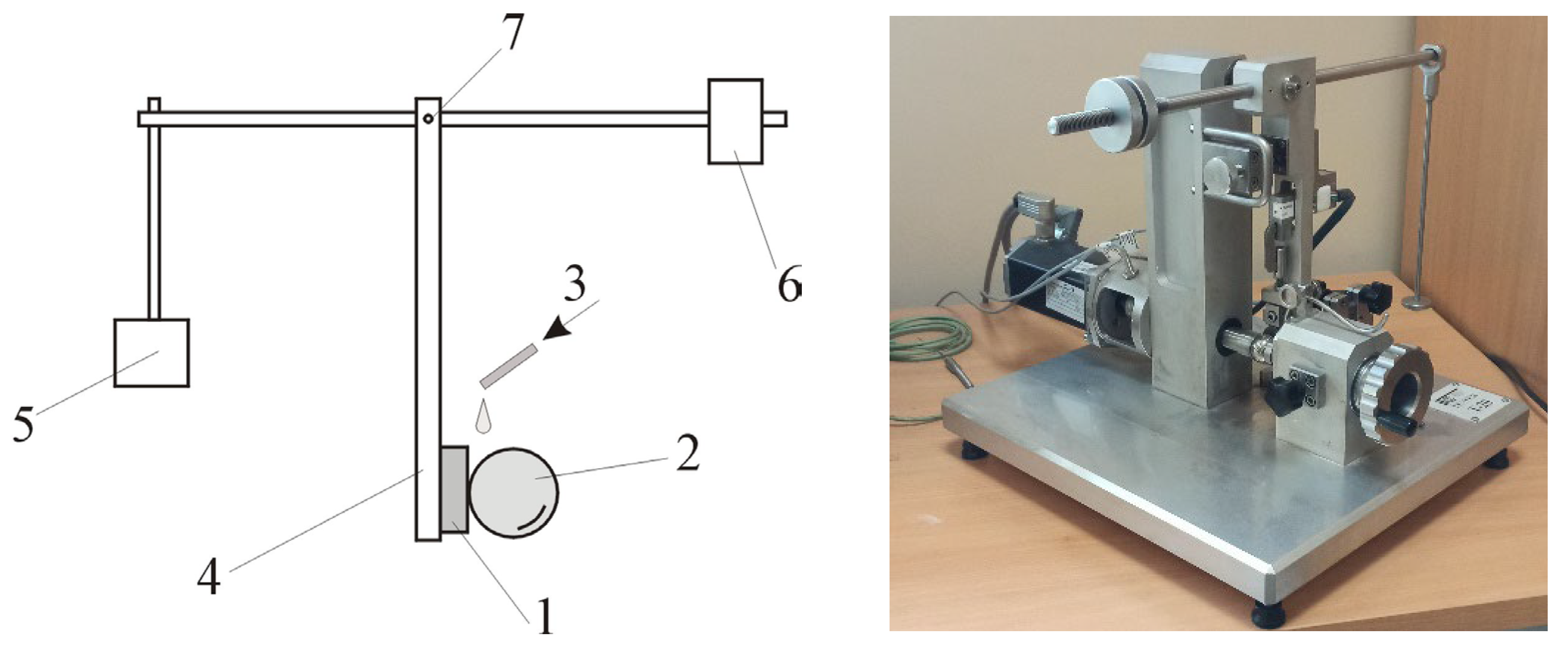
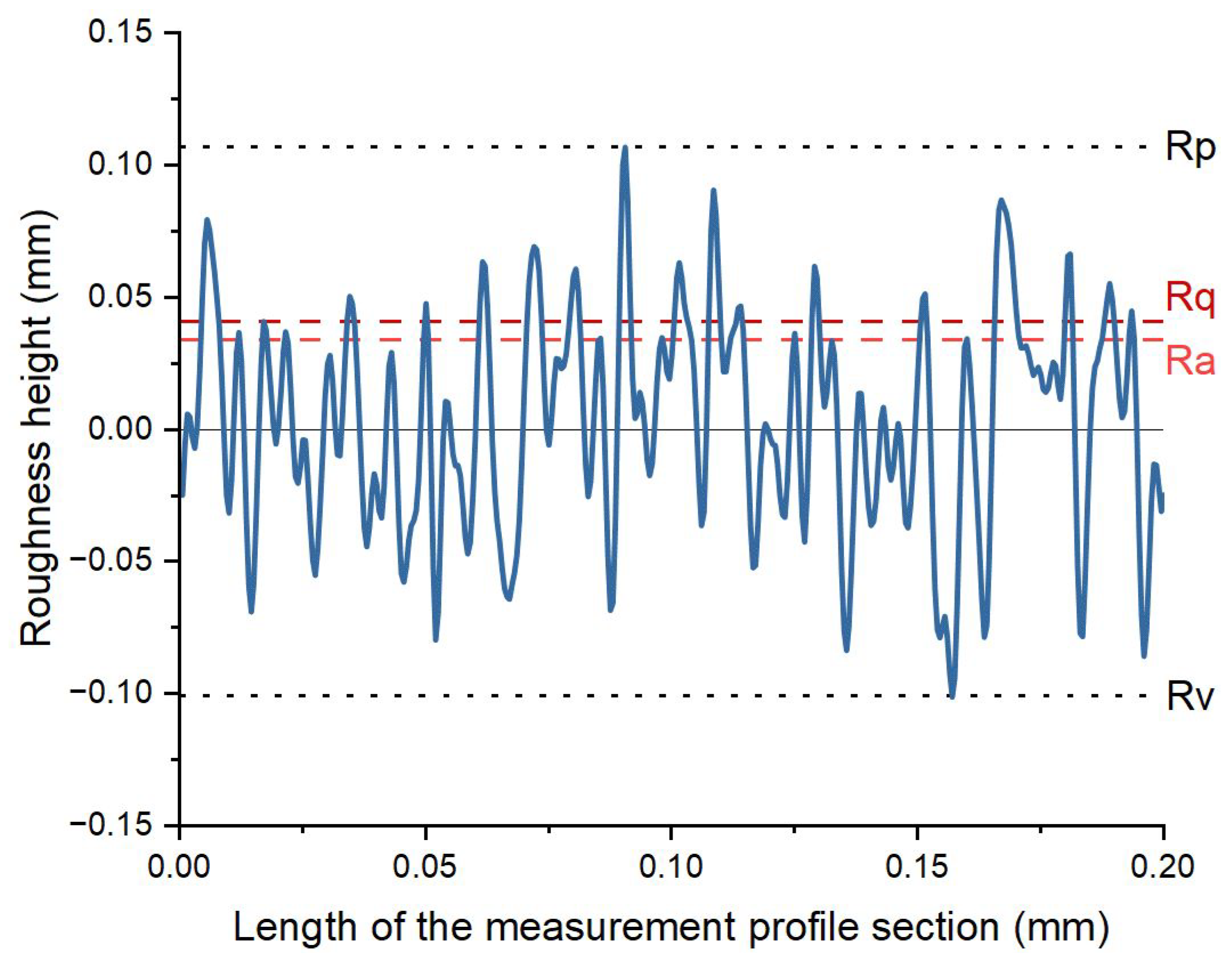
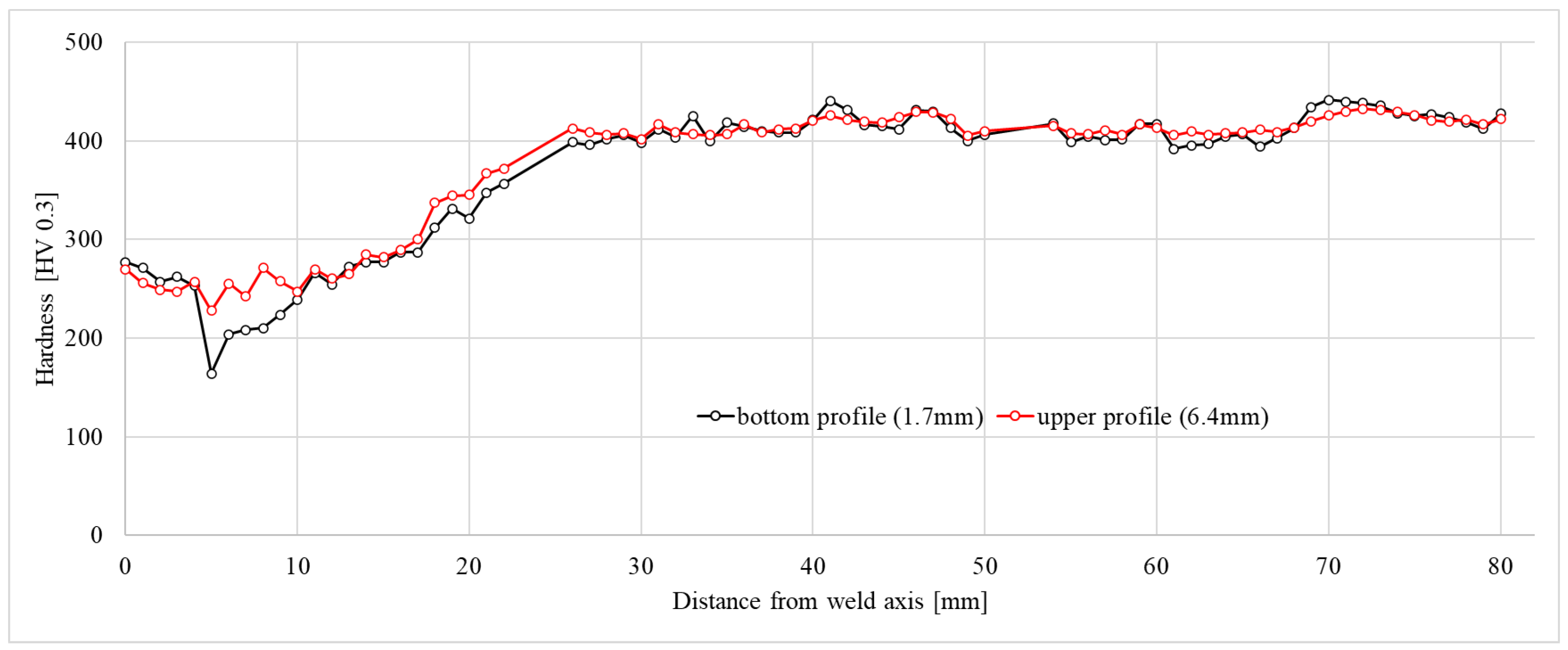
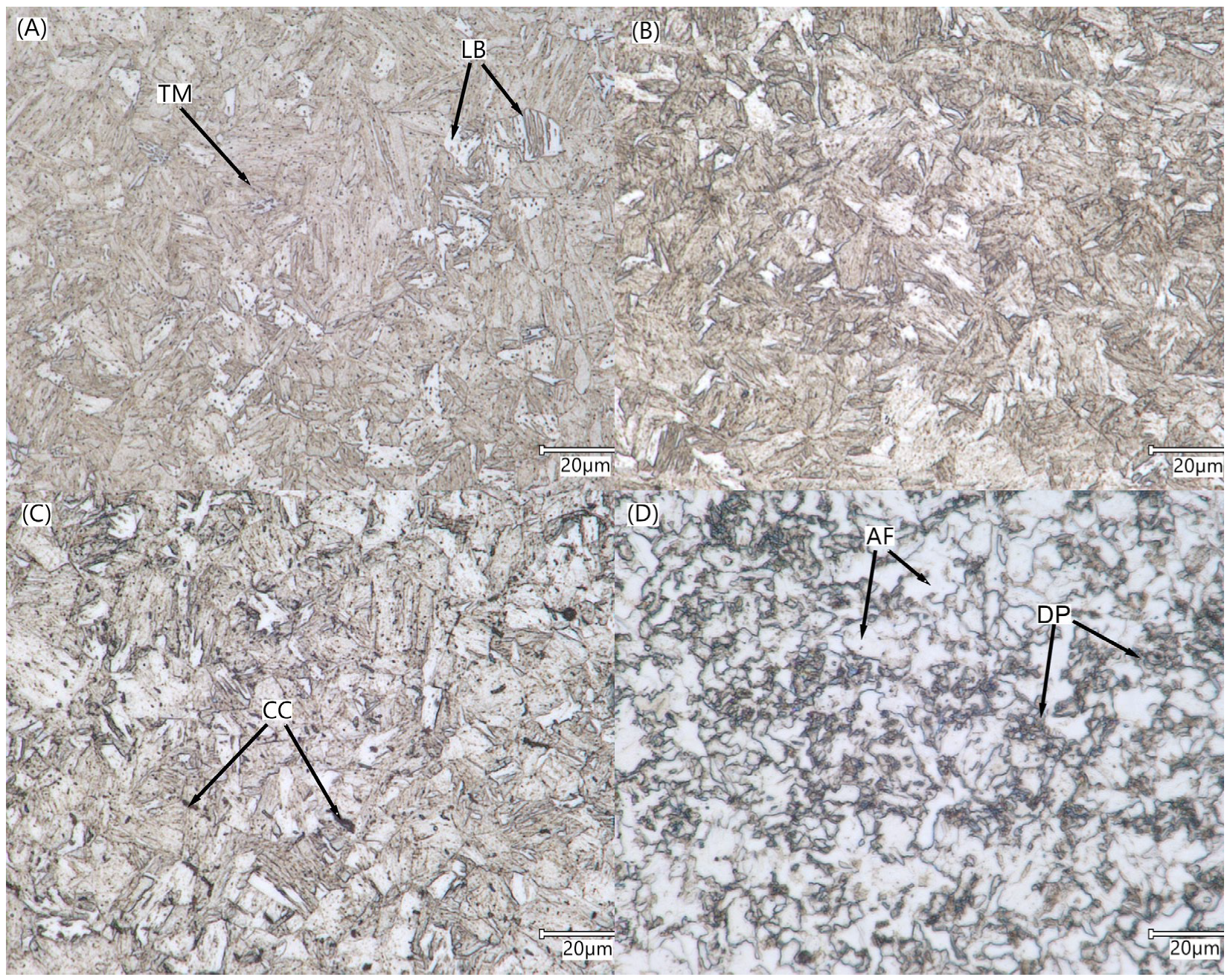
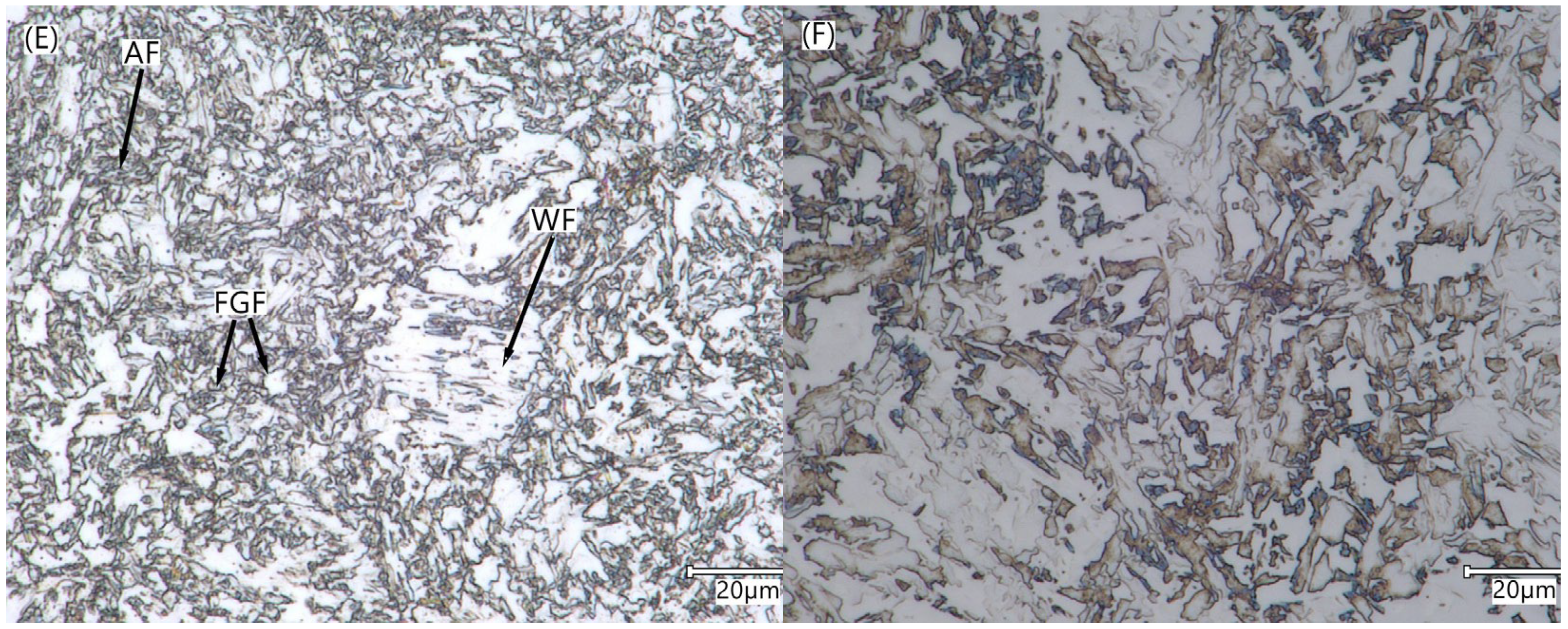
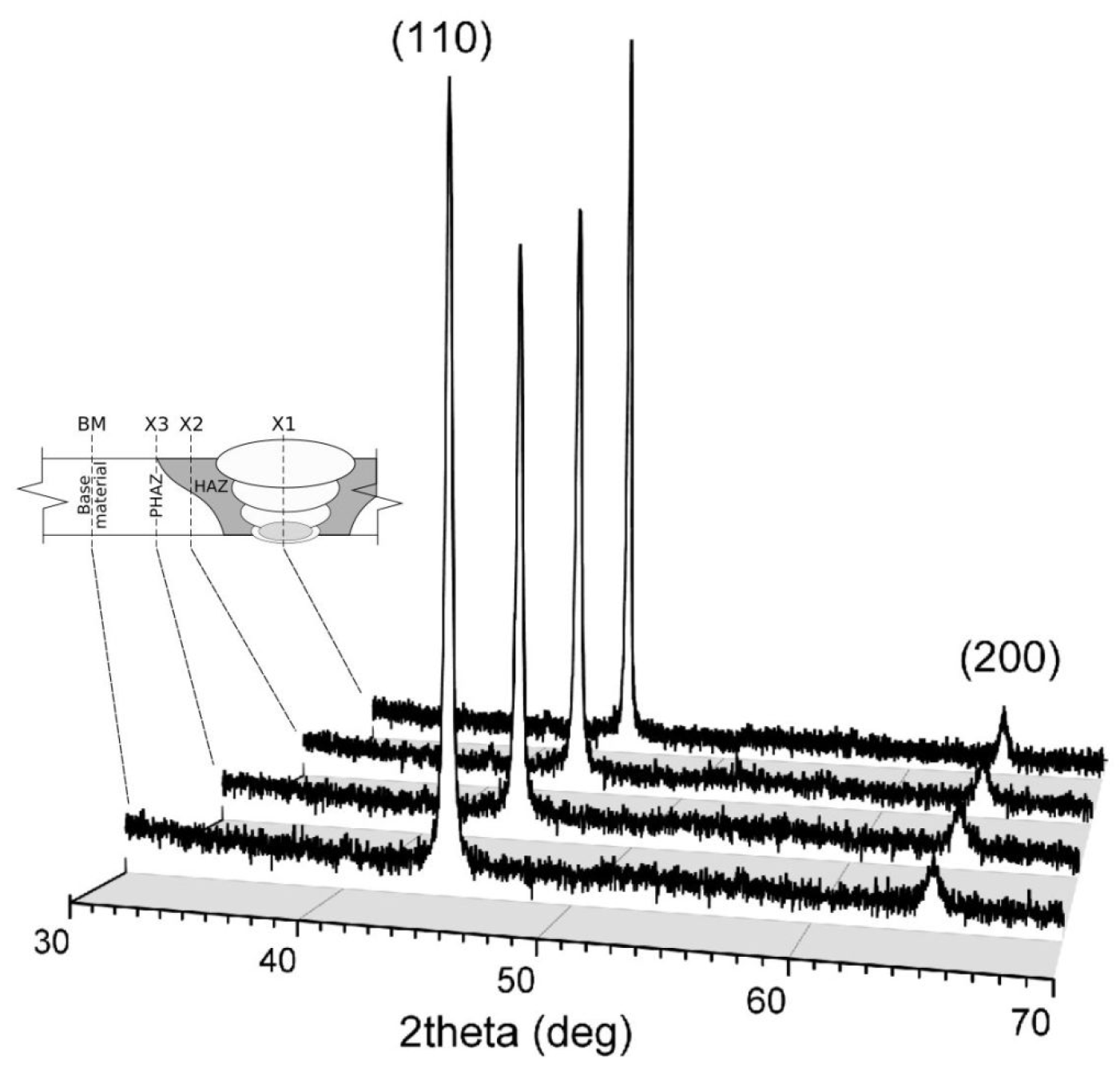
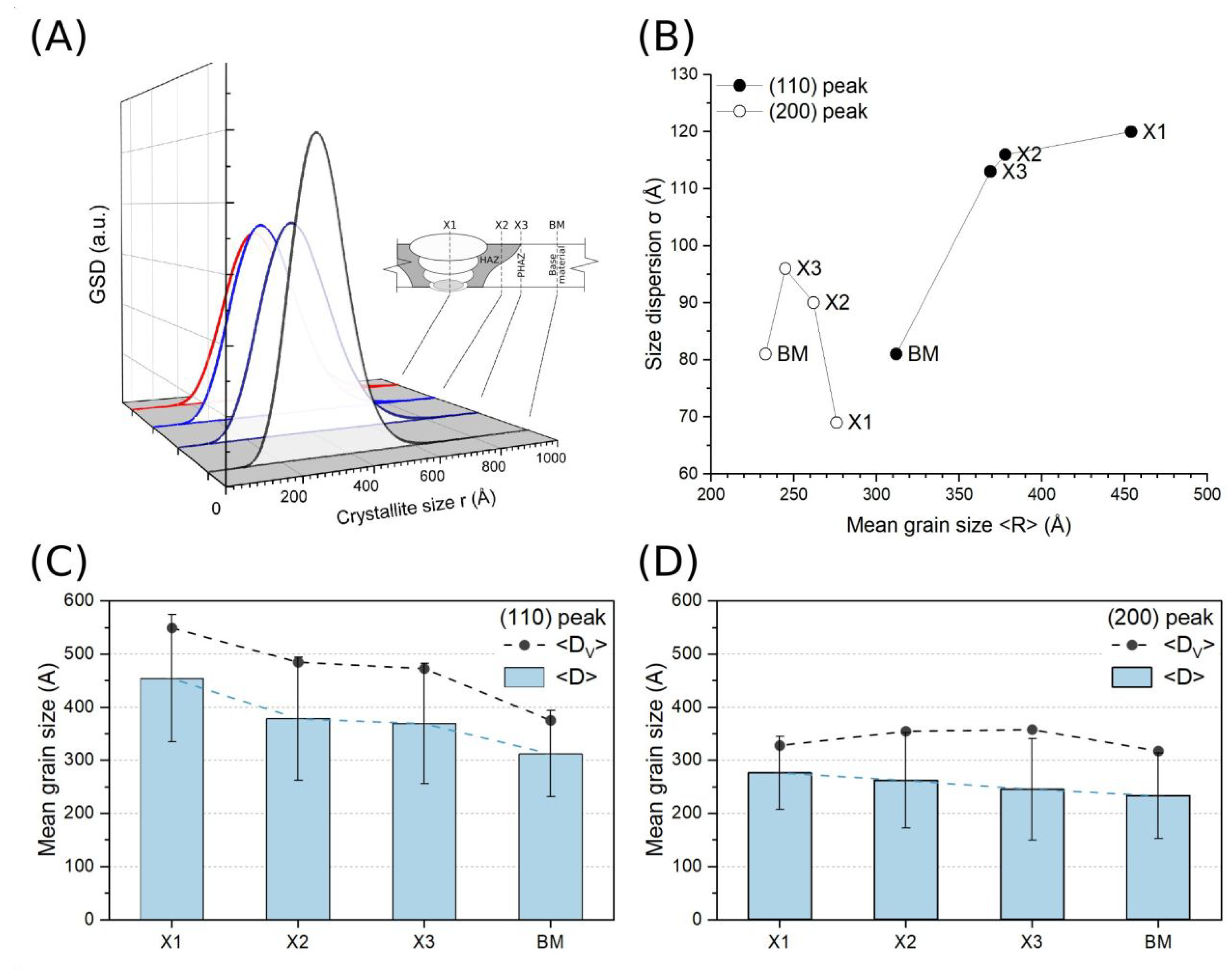
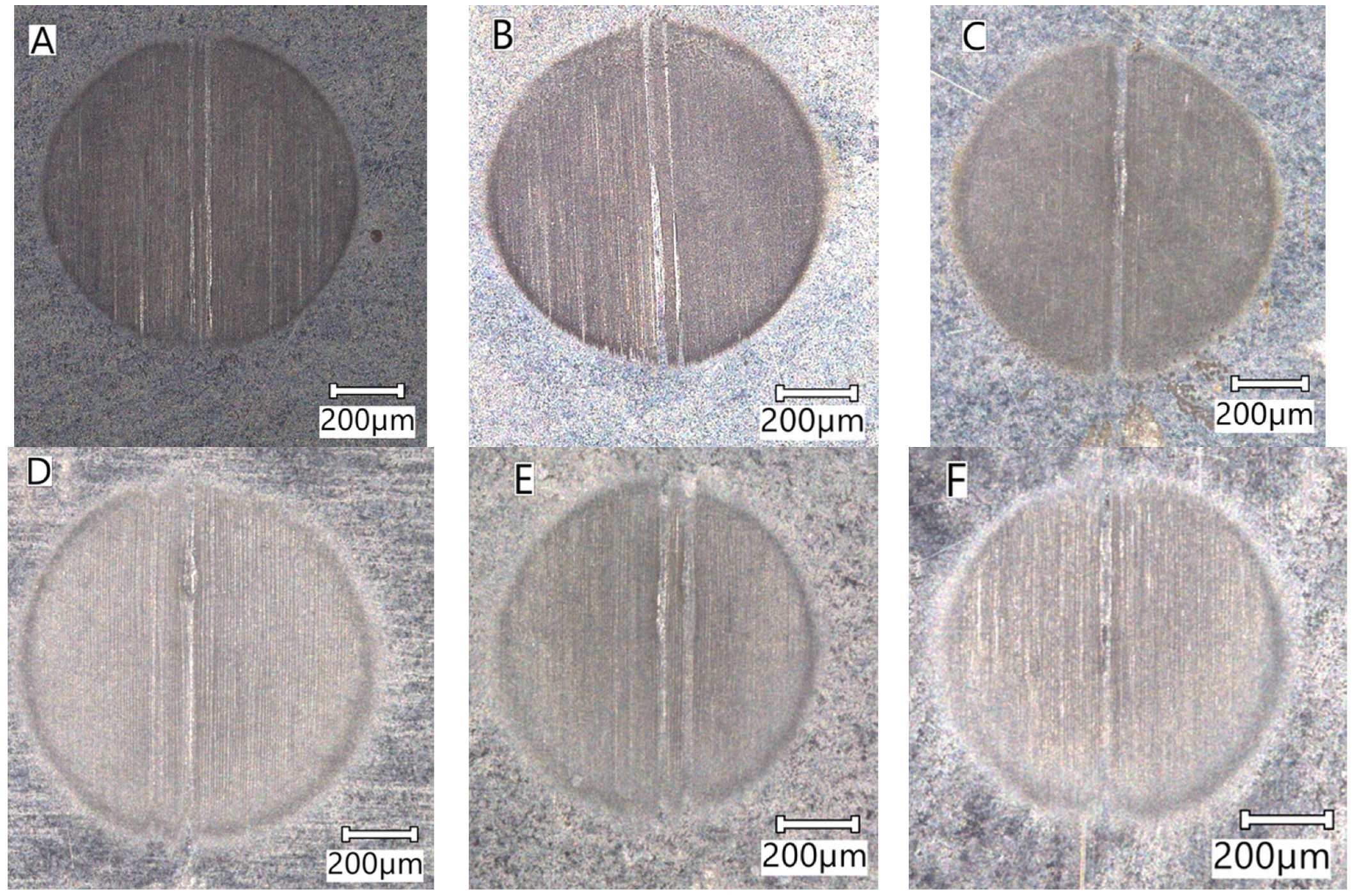

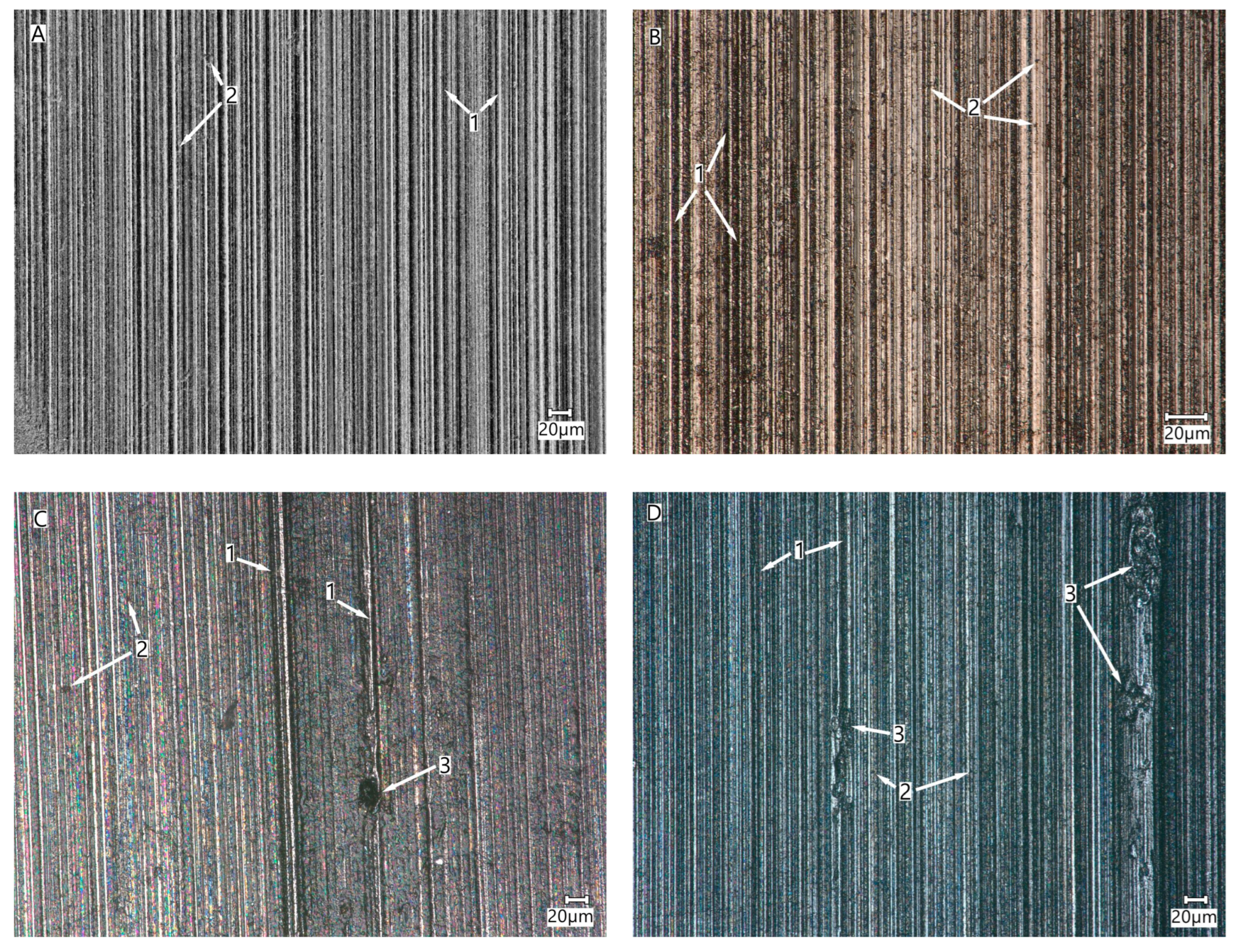
| Declared Chemical Composition [% w/w] | |||||
|---|---|---|---|---|---|
| C Max. | Si Max. | Mn Max. | Cr Max. | Mo Max. | B Max. |
| 0.2 | 0.8 | 1.5 | 1.0 | 0.5 | 0.005 |
| Stitch | Current (A) | Voltage (V) | Travel Speed (mm/min) | Gas Flow (l/min) | Heat Input (kJ/mm) |
|---|---|---|---|---|---|
| 1 | 105 | 18.8 | 96 | 15 | 1.2 |
| 2 | 215 | 28.3 | 235 | 15 | 1.55 |
| 3 | 220 | 28.7 | 294 | 15 | 1.3 |
| 4 | 215 | 28.7 | 265 | 15 | 1.4 |
| Shrinkage groove | 105 | 18.8 | 96 | 15 | 1,2 |
| Profile | R |
|---|---|
| λs | 2.5 µm |
| Ra | 0.034 µm |
| Rq | 0.041 µm |
| Rz | 0.208 µm |
| Cross-Sectional Axis | (110) | (200) | ||||||
|---|---|---|---|---|---|---|---|---|
| Mean Grain Diameter <D> | Size Dispersion σ | Shape Factor m | Volume-Weighted Mean Diameter <DV> | Mean Grain Diameter <D> | Size Dispersion σ | Shape Factor m | Volume-Weighted Mean Diameter <DV> | |
| Å | Å | - | Å | Å | Å | - | Å | |
| X1 | 454 | 120 | 13 | 550 | 276 | 69 | 15 | 328 |
| X2 | 378 | 116 | 9.8 | 485 | 262 | 90 | 7.6 | 355 |
| X3 | 369 | 113 | 9.7 | 473 | 245 | 96 | 5.5 | 358 |
| BM | 312 | 81 | 14 | 375 | 233 | 81 | 7.4 | 317 |
Disclaimer/Publisher’s Note: The statements, opinions and data contained in all publications are solely those of the individual author(s) and contributor(s) and not of MDPI and/or the editor(s). MDPI and/or the editor(s) disclaim responsibility for any injury to people or property resulting from any ideas, methods, instructions or products referred to in the content. |
© 2023 by the authors. Licensee MDPI, Basel, Switzerland. This article is an open access article distributed under the terms and conditions of the Creative Commons Attribution (CC BY) license (https://creativecommons.org/licenses/by/4.0/).
Share and Cite
Ligier, K.; Bramowicz, M.; Kulesza, S.; Lemecha, M.; Pszczółkowski, B. Use of the Ball-Cratering Method to Assess the Wear Resistance of a Welded Joint of XAR400 Steel. Materials 2023, 16, 4523. https://doi.org/10.3390/ma16134523
Ligier K, Bramowicz M, Kulesza S, Lemecha M, Pszczółkowski B. Use of the Ball-Cratering Method to Assess the Wear Resistance of a Welded Joint of XAR400 Steel. Materials. 2023; 16(13):4523. https://doi.org/10.3390/ma16134523
Chicago/Turabian StyleLigier, Krzysztof, Mirosław Bramowicz, Sławomir Kulesza, Magdalena Lemecha, and Bartosz Pszczółkowski. 2023. "Use of the Ball-Cratering Method to Assess the Wear Resistance of a Welded Joint of XAR400 Steel" Materials 16, no. 13: 4523. https://doi.org/10.3390/ma16134523
APA StyleLigier, K., Bramowicz, M., Kulesza, S., Lemecha, M., & Pszczółkowski, B. (2023). Use of the Ball-Cratering Method to Assess the Wear Resistance of a Welded Joint of XAR400 Steel. Materials, 16(13), 4523. https://doi.org/10.3390/ma16134523







